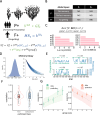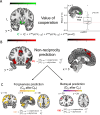A neurocognitive mechanism for increased cooperation during group formation
- PMID: 39715935
- PMCID: PMC11666775
- DOI: 10.1038/s44271-024-00177-3
A neurocognitive mechanism for increased cooperation during group formation
Abstract
How do group size changes influence cooperation within groups? To examine this question, we performed a dynamic, network-based prisoner's dilemma experiment with fMRI. Across 83 human participants, we observed increased cooperation as group size increased. However, our computational modeling analysis of behavior and fMRI revealed that groups size itself did not increase cooperation. Rather, interaction between (1) participants' stable prosocial tendencies, and (2) dynamic reciprocal strategy weighed by memory confidence, underlies the group size-modulated increase in cooperation because the balance between them shifts towards the prosocial tendency with higher memory demands in larger groups. We found that memory confidence was encoded in fusiform gyrus and precuneus, whereas its integration with prosocial tendencies was reflected in the left DLPFC and dACC. Therefore, interaction between recall uncertainty during reciprocal interaction (i.e., forgetting) and one's individual prosocial preference is a core pillar of emergent cooperation in more naturalistic and dynamic group formation.
© 2024. This is a U.S. Government work and not under copyright protection in the US; foreign copyright protection may apply.
Conflict of interest statement
Competing interests: The authors declare no competing interests.
Figures






Similar articles
-
Prosocial Orientation Alters Network Dynamics and Fosters Cooperation.Sci Rep. 2017 Mar 23;7(1):357. doi: 10.1038/s41598-017-00265-x. Sci Rep. 2017. PMID: 28336925 Free PMC article.
-
Relationship between cooperation in an iterated prisoner's dilemma game and the discounting of hypothetical outcomes.Learn Behav. 2005 Aug;33(3):324-36. doi: 10.3758/bf03192861. Learn Behav. 2005. PMID: 16396079
-
Shifting prosocial intuitions: neurocognitive evidence for a value-based account of group-based cooperation.Soc Cogn Affect Neurosci. 2020 Jun 23;15(4):371-381. doi: 10.1093/scan/nsaa055. Soc Cogn Affect Neurosci. 2020. PMID: 32337604 Free PMC article.
-
Heuristics guide the implementation of social preferences in one-shot Prisoner's Dilemma experiments.Sci Rep. 2014 Oct 28;4:6790. doi: 10.1038/srep06790. Sci Rep. 2014. PMID: 25348470 Free PMC article.
-
Extortion - A voracious prosocial strategy.Curr Opin Psychol. 2022 Apr;44:196-201. doi: 10.1016/j.copsyc.2021.08.033. Epub 2021 Sep 9. Curr Opin Psychol. 2022. PMID: 34710851 Review.
References
-
- Trivers, R. L. The evolution of reciprocal altruism. Q. Rev. Biol.46, 35–57 (1971).
-
- Axelrod, R. & Hamilton, W. D. The evolution of cooperation. Science211, 1390–1396 (1981). - PubMed
-
- Nowak, M. A. & Sigmund, K. Tit for tat in heterogeneous populations. Nature355, 250–253 (1992).
LinkOut - more resources
Full Text Sources
